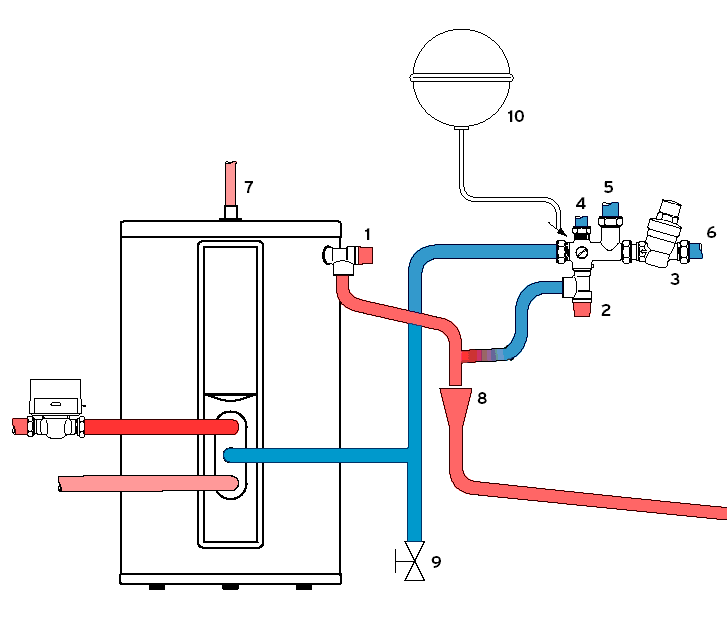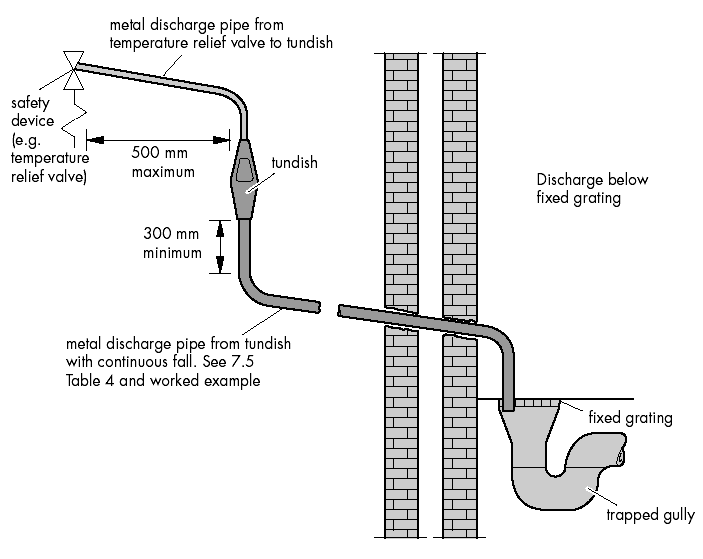Unvented DHW
Like a conventional hot water cylinder fed from a tank in the roof, an unvented cylinder contains hot water (heated by a boiler or immersion heater) which directly supplies the hot taps. Unlike a conventional cylinder, however, the water in the unvented cylinder comes directly from the cold water main and is at (nearly) mains pressure.
To contain this pressure the cylinder has to be physically much stronger than in a gravity-fed system. Unvented cylinders are made of thicker copper or stainless steel, and are usually more expensive than normal cylinders designed for vented operation.
Considerations for installation
When considering an unvented cylinder, there are several considerations to check first. Failure to do this could result in unsatisfactory performance, or a system not well suited to the actual requirements.
To function well, you need adequate mains pressure and an adequate flow rate (these are not the same thing). Ideally your mains pressure should be in the range of 2 - 10 bar (systems with less pressure may still work, but you will lose performance, and may find you get better results with a conventional header tank).
The mains flow rate should be a minimum of 20 lpm. (more is better). Keep in mind that the mains supply will need to meet all the household demands concurrently - hot and cold.
Advantages of Unvented cylinders
- Mains pressure hot water to all outlets
- High flow rates of water at "mix temperature"[1]
- Fast reheat
- No requirement for a header tank in the loft
- Work well in properties without adequate height available for gravity fed systems (flats, chalet style houses etc)
- Can be heated by multiple sources, e.g. gas boiler, immersion heater, solar collector.
- [1] i.e. water at higher than final use temperature that you will mix down by the addition of cold water.
Disadvantages
- More complex controls required than with a conventional vented system or combination boiler
- More expensive component costs (although total system price may be similar depending on the labour required)
- Need an adequate and reliable mains water supply
- Need annual servicing, possibly incurring extra cost
- Can't be heated by solid fuel stoves etc.
The components of an unvented cylinder
In addition to the cylinder itself, there are several other components needed to form a functional system.
- Temperature and pressure relief valve
- Expansion relief valve
- Pressure limiting valve (usually combined with a filter / strainer)
- Connection for a secondary return (often provided by an extra tapping on the cylinder)
- Balanced pressure cold water outlet
- Main cold supply inlet
- Outlet to DHW
- Tundish
- Drain Point
- Expansion Vessel
Connections to the primary heating flow and return are shown to the left (with two port zone valve).
Valves
- A check valve (which is usually implemented as part of the pressure reduction valve).
- A pressure reduction valve typically set to around 3 bar (although other pressures are sometimes used).
(Note, Small unvented storage cylinders of less than 15 litres don't have these, and the small amount of expansion is accommodated by backing the water back into the mains. The only requirement is to check that all stop valves upstream are not of the 'loose jumper' type which could act as a non-return valve and block the expansion).
There may also be a cold water outlet point after the pressure reducing valve to supply e.g. shower mixing valves which work better when their hot and cold supplies are at the same pressure.
- A pressure relief valve (typically set to 6 bar), this is mounted on the inlet to the cylinder.
The above items are often found combined into a single multifunction unit.
- A combined over pressure and temperature relief valve. This is always on the side of the cylinder. It will typically be set to 7 bar and 90C. The thread that is used for this fitting is unique to this type of device to avoid the hole being used for any other purpose and so that the only way to block the hole is to install the valve.
(The reason for the temperature limiting valve in addition to a pressure limiting one is so that if a heating source fails to cut out, it is possible for the pressure rise will remain quite modest until the water reaches well over 100C (even 1 bar will raise the boiling point to around 120C). So neither pressure relief valve would open and yet the contents of the cylinder would be lethal and will 'flash' boil to steam when pressure in the system is reduced by opening a tap. Should this valve operate, it will dump some of of the contents of the cylinder (containing water at 90C!) into the relief discharge pipework. The valve will only close when cooler water from the mains supply has reached it. This is also why there are stringent requirements for the size, length and routing of the discharge pipe.
Thermal Cutout
The thermostats for the immersion heater (if fitted) and the boiler (if connected) will contain a second higher temperature cut-out requiring manual resetting if it operates.
Discharge Pipe
The pressure relief and over temperature valves discharge into an emergency relief discharge pipe. They are usually combined and connected to a tundish, which in turn feeds the discharge pipe. The tundish provides an air gap required between anything connected directly to a mains water supply, and a drain so as to prevent any possibility of back contamination of the mains supply. It also provides a visible indication of any loss of water via the safety valves. The discharge pipe must be metallic and of at least 22mm diameter.
The maximum effective length of pipe from the tundish is also specified:
| Minimum size of discharge
pipe pipework from tundish |
Maximum effective
length |
Effective length of
each elbow or bend |
|---|---|---|
| 22mm | 9m | 0.8m |
| 27mm | 18m | 1.0m |
| 35mm | 27m | 1.4m |
There must be a vertical drop of pipe after the tundish (minimum length of 300mm) before any bends. The discharge pipe must terminate outside of the building in a safe place such as a gully where it can't cause injury.
Expansion vessel
An expansion vessel usually required to absorb the expansion of the water as it is heated. The volume of this will vary with the size of the cylinder. This is also normally connected to the multipurpose valve described above. The expansion vessel is pre pressurised with air (or nitrogen) contained in a bladder. There is typically a shrader valve (like that on a car tyre) fitted to the vessel to allow its pressure to be checked and if necessary replenished).
Note some unvented cylinders may have an internal pressure relief bladder or "bubble" - although these are less common now.
Other requirements
- The indirect heating coil connection must contain at least one 2-port zone valve.
- The use of solid fuel heating is forbidden.
Note that qualification for working on these units is known informally as a "G3" card since Part 3 of the building regs approved document G used to specifically cover just the installation of unvented hot water vessels. Later versions of approved document G hwoever now cover all hot water storage systems, not just unvented systems.
Safety of unvented systems
A properly installed and maintained system will be as safe (or in many cases safer than) as any other hot water system.
Water expands as it is heated. Since the outlet of the cylinder is to DHW taps which are normally closed, and the inlet is from the cold water main which may incorporate non-return (check) valves or other devices preventing expansion back into the supply pipe, measures have to be provided to accommodate the expansion of the hot water which could otherwise give rise to enormous pressure in the cylinder. These take the form of some type of container of gas which can be compressed as the water expands. This may be arranged as a bubble of air in the cylinder or a separate expansion vessel.
At normal atmospheric pressure water boils at 100C. At higher pressures the boiling point increases so that pressurised water can be heated to over 100C and remain liquid. However if the pressure is released it will rapidly turn to steam, expanding greatly and causing a steam explosion. In the days of steam the explosion of boilers or pipework in locomotives, shipping and industry was rightly feared for the destruction and loss of life it caused. If the water in an unvented hot water cylinder is allowed to rise above 100C then the reduction of pressure when a tap is opened could cause a steam explosion. For this reason unvented systems must have safety systems to control the temperature and pressure of the water, these systems must be checked annually, and their installation and servicing must be carried out by technicians with adequate knowledge and training for these tasks.
Servicing requirements
Regular service and maintenance of unvented systems is vital and should typically be carried out annually. Maintenance tasks should include:
- Clean and inspect the strainer in the cold water supply to the Pressure reduction valve
- Inspection of pressure / temperature relief valve and expansion relief valve
- Manual operation of each relief valve to ensure that water flows freely to the tundish, and that they reseat correctly.
- Check of the pressure in the expansion vessel, and top up if required
Manufacturers:
There are many manufacturers of unvented cylinders including: Telford, Albion, Heatrae Sadia (the market leader whose model Megaflow is used as a synonym for all other makes and models), Santon, Gledhill, Elston, IMI, & Vaillant.

